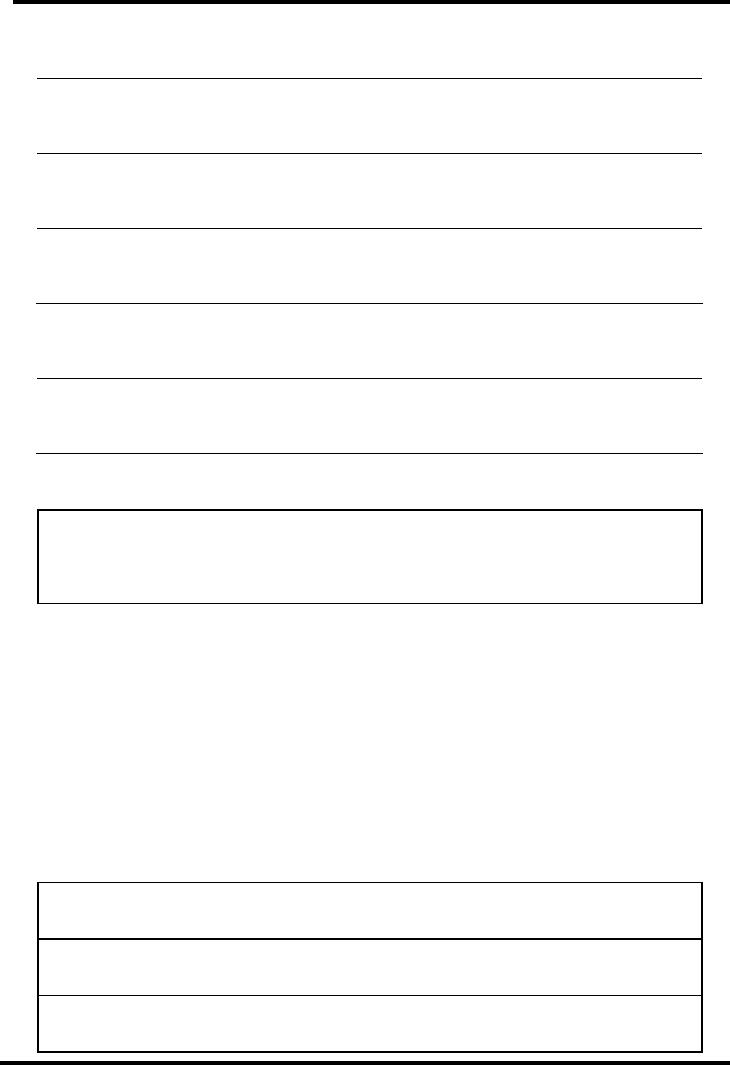 |
WRITING FEATURES:GENERATING FEATURE STORY IDEAS |
| << EDITORIAL WRITING:WRITING AN EDITORIAL:STRUCTURING AN EDITORIAL |
| WRITING COLUMNS:Column and a news report, Purpose, Audience >> |

Journalistic
Writing MCM310
VU
LECTURE
37
WRITING
FEATURES
WHAT'S
A FEATURE? THE BASIC
SCOOP:
A
news feature goes way
deeper than the headlines it
explores an issue thoroughly. To
write one requires
plenty
of research and interviewing.
Yes, it takes some honest
toil to create something
worthwhile, but it's
fun
especially once you see the
result of all that hard
work.
TYPES
OF FEATURES:
�
Human
interest features
�
News
features
�
Personality
profiles
�
Personal
experience narratives
�
How-to-Stories
�
Historical
features
�
Brites
EXAMPLE
OF BRITES:
Ready,
aim, bake!
Joe
Carle of Westland called police
Sunday night after he heard
gunshots hitting his house.
He told
police
someone was shooting from
outside.
But
police found Carle, 31, had
placed a loaded semiautomatic handgun in
his oven that night,
forgot it
was
there, then turned on the oven.
The gun warmed up and fired
bullets through the oven into the
kitchen
walls.
No one was hurt.
Police
didn't know why Carle
put the gun in the oven.
WHAT
TO FEATURE IN A FEATURE?
Features
can run up to 10,000 words
in length. Even if your story is only
one tenth as long (YPP
features tend
to
be from 1000-1500 words in length), it's
important to have a clear
idea of what you are going to
write about
and what specific angle you
will explore as you get
started.
GENERATING
FEATURE STORY
IDEAS
1.
Start with your own
experience
2.
Community you are part
of
3.
Read the papers and listen to
newscast
4.
Clip saving
5.
Fact files: who, what,
where, etc
6.
History
7.
Hobbies
8.
Dreams: nearly everyone
wants to be rich.
9.
How and why behind a
news event
Story
mapping can
keep you from wasting a
lot of time doing research
that you won't be able to
use. Here's
an
example of how to focus a
feature by using the technique of story
mapping. We'll look at raves
once again:
You
love raves, and want to do a
story on them. OK, cool,
you've
got your initial idea. But
what exactly are
you
going to write about? For
every general story idea,
there are many angles, or
ways the story can
be
141

Journalistic
Writing MCM310
VU
handled.
For
instance, a story about raves could
address the drugs, the venues, the
music, the dangers, the
police,
parents, the rave culture, clothing,
trends...the list goes on
and on. If you try to
cover everything, you
will
have zero focus. Without a
clear angle, the likely
result after lots of hard work will be
one big mush!
Narrow
your idea down to a few main
sub-topics. Choose
sub-topics that relate
logically, and you will
find
it
easier to focus your story.
For example, to write a
feature on raves, you might
choose to focus on
drugs,
recent
trends and music.
Your
next step is to brainstorm
as many angles as you can
within each sub-topic, the
same way you
did
the
main story idea. What
possible details are there
to touch upon?
Break
down drugs: The physical
effects, the peer pressure, the
prices, the quality, the testing
process, bad trips,
the
potential for dying, for getting
busted.
Break
down trends: What's cool in
the scene and what's not?
What's the future? Are raves
becoming too
trendy?
Is there a dominant style?
How do trends relate to the kinds of
drugs people take?
Break
down music: What's hot?
What's not? What are the
different styles and scenes?
What kind of equipment
is
used? Who are famous
DJs? What is house? Techno?
Happy Hardcore?
Trance...
Based
on the angles you come up
with, decide what the
main angle for your story
is.
Suddenly, you have
an
interesting story about raves waiting to
happen. It's straightforward, and
will be relatively easy to
write
because
you know where you want to
go, and what types of
information you need to take
you there.
What's
next?
As
always, you need to become
an expert in your subject. Go out
and get the information. You
will need to do
some
research on the net or in a library, talk
to people on the phone and set up
your key face-to-face
interviews.
A
reporter has to hustle to
get their facts straight.
Find a
DJ to profile and set up an
interview. Go to some
raves,
check out the trends; what
are people wearing and
taking? Take notes. Go to
rave wear stores and
get
prices.
Figure out how to talk to
some designers. What are the
latest rumours about drugs?
Who's doing what
and
why? Make sure you
interview some ravers so you
can ground your story
through their first-hand
voices.
Youth
journalists should strive to represent youth
perspectives as often as
possible.
The
entire time you are doing
your research, REMEMBER TO
KEEP YOUR FOCUS. Keep asking
yourself
what
information you really need.
When you get extra
information (which you most certainly
will), don't get
bogged
down and distracted by it.
If you stay true to your
focus, you will spend
your time and energy
doing
research
efficiently. Once you've got
all the information you need
to cover your chosen angles,
and then
transcribe
your tapes (if you
record interviews) and notebooks.
IT'S
TIME TO WRITE!
Are
you ready to get funky?
Features are the crown jewel of
news stories, where you
can use colourful
language
and
have some freedom to express yourself.
Whereas hard news stories
concentrate on the facts just the
facts
news features blast past
those limitations. This is where
you get to show off
and be creative as a writer.
Test
your
limits; push your use of
language and your ability to set a
scene. You
are the Storyteller now.
There's
no one right way to write,
and there's no single best
way for you to tell
your story, so trust
yourself...insist
on coming up with an original and
effective approach. The more
work you put into
story
development
and research, the more you
can go with the flow of your
notes when you actually sit
down and
write
the feature.
Try
to make your reader feel
like they are there.
Your
writing can trigger all five
senses!
You
can think of a feature story as a
series of mental images,
presented one after the other. If
these scenes are
developed
thoughtfully, creatively and
skilfully, they can come together in
extraordinary ways to create a
142

Journalistic
Writing MCM310
VU
beautiful
montage.
Consider
the story about raves. A
great feature will put the
reader INSIDE the club, next to the DJ
(what does
s/he
looks like, smell like,
sound like...does s/he wear
their headphones crooked on their
head, or around
their
neck), in the mind of a 17 year-old
taking "E," make them feel the
music washing over the
swaying crowd,
connect
the trends they learned about with the
outfits of the dancers gyrating
by.
What's
the point of your
story?
In
a feature, you have some
room to develop your ideas
and your characters (much
like in a play or a short
story).
You don't
have
to start with a lead that
summarizes the whole
piece.
If
you create a vivid
atmosphere for your readers,
it can be very effective to have your
characters narrate the
story
from within that
scene.
Say
the rave story starts off
right in the heart of a club: the lights, the
beats, the gear, the heat,
and the
turntables.
The description ends with the
turntables, and the DJ takes
over telling the story in one's
own words.
By
sharing some details about
other aspects of the club, and
quoting other ravers and
DJs, the whole
feature
can
unfold within the atmosphere of the
party. Just
be sure that whatever
approach you use allows you
to
stay
with the initial idea and
main sub-topics.
Your
role as a feature writer is
that of narrator. You
take all the pieces of
information that you've
assembled
and
decide how to put them together.
Build a complete jigsaw
puzzle, using your own
perspective to envision
and
then assess the final
result.
Remember
that your opinions shouldn't enter a
feature story. You
are there to fairly and
accurately
represent
different people, and to let
the reader draw their own
conclusions about who and what to
believe.
FEATURE
LEADS:
1.
Question lead:
Is it better
to buy new or used
textbooks?
Should
the death penalty be abolished?
Do
birds aim?
2.
Direct address:
Would
you like free season
football tickets and a
ride to the stadium?
Tired
of smoky cafes, sleazy
pickup lines and stale
pretzels? Then try the
newest single scene:
cyberspace
3.
Quotations:
At
the end it was Cassie who
told her mother not to
cry.
"I
had started to cry," Angela
said, "and Cassie looked at
me and said, `Don't cry,
Mother, even when I
die,
don't cry,' and then
she went quietly to
sleep."
-Lexington
Herald-Leader
4.
Anecdotes:
Gretchen
Brown, president and chief
executive officer of Hospice of the
Bluegrass, remembers the
well-intentioned
but confused college student
who called her one
day. "I asked him, `Do
you know
what
hospice is?' and he said,
`Oh, that's where they kill
people.'"
5.
Allusion:
At
the Berks County jail, crime
doesn't pay. The inmates do:
$ 10 a day for room and
board no credit
cards
accepted. -Wall Street
Journal
143

Journalistic
Writing MCM310
VU
6.
Contrast:
Richard
Roy Grant was, by all
appearance, a life insurgence
agent, a beloved husband and stepfather,
a
kind
neighbour, a caring
friend.
He
was also a burglar, whose
speciality was breaking into the
homes of high school
athletes while their
families
were away, watching their
sons play football.
Associated
Press
7.
Descriptive leads:
Every
day the factory whistle bellowed forth
its shrill, roaring, trembling
noises into the
smoke-
begrimed
and greasy atmosphere of the workingmen's
suburb; and obedient to the
summons of the
power
of steam, people poured out of little
grey houses into the street.
With sombre faces
they
hastened
forward like frightened
roaches, their muscles stiff
from insufficient sleep. In the
chill
morning
twilight, they walked through the
narrow, unpaved street to the tall
stone cage that waited
for
them
to welcome the people with deafening
sounds floated about--the heavy
whir of machinery, the
dissatisfied
snort of steam. Stern and
sombre, the black chimneys
stretched their huge, thick
sticks high
above
the village. No mercy!
REVISION
AND EDITING
Always
reread your work. Read it
out loud; read it as if you
have no knowledge of the subject; pretend
you are a
critical
editor seeing it for the
first time; pretend you are one of
your targeted readers. Do
your own grammar
and
spell check. If
possible, let it sit for a
couple days and then read it
again. This
is the beauty of re-
vision:
you'll be amazed by all the improvements
you can make when you
look at it with a fresh
perspective.
Also,
consider printing it out and
reading it as printed text,
because things read differently on
paper than they
do
on screen.
It
sucks to have words that
you sweated and slaved
over deleted with the click of a
button, but editing
and
cutting
in particular almost always has to
happen. Though you need to
try and edit yourself as
ruthlessly as
possible,
it's almost impossible to have an
editor's perspective when you
are the author. It helps to
hear
someone
else suggest what passages they
think aren't crucial, what sentences
need to be tightened up, where
there's
clutter that can be
eliminated.
It
can be incredibly hard to see your
writing cut up, but that, after all, is
why editors exist. The
lesson to be
learned
when it comes to dealing
with editors is to cultivate
a thick skin. To
master the craft of writing
you
have
to discipline yourself to hear criticism without
construing it as a personal attack. If
your piece of writing
is
too
long (as most are,
once you're trying to squeeze
into a word count allotted
to you by a publication),
then
something
has
to be
cut, you may not
like it, but you
have to accept it.
Of
course, you must struggle to
find a balance; as the author
you are ultimately
responsible for keeping
the
heart
of your story intact...alive...vibrant!
So you can't accept every
suggested revision, but you
also can't stake
your
feelings to every sentence
you've ever written. Not if
you want to be a published writer.
When
your piece appears in print,
don't be surprised if you
find changes have been
made to your story
that
you've
never seen. Again, don't
take it personally when your
work is revised. Sometimes it's done to
better suit
the
style of the publication. Sometimes it's
minor grammar alterations.
And sometimes there's such
major
cutting,
pasting and rewording that
it's hard to recognize your story
anymore. When this happens,
don't scream
and
threaten your editor. Calmly
express your concerns at an appropriate
time, and if the editor isn't
willing to
accommodate
you and you don't want it to
happen again, don't submit
anything else to that
publication.
HINT:
If you
get sick and tired of
reading over your own
piece during the revision process,
show it to a
friend.
They will see things that you
can't guarantee!
YPP
Writer's Guide: A Handbook
for Youth Journalists
48
144

Journalistic
Writing MCM310
VU
ACTIVITY:
UNDERSTANDING A FEATURE
Find
a feature and read it carefully.
What is the feature about, in your
own words...the main,
focused idea?
Cite
three major sub-topics, or angles,
used to explore aspects of the main
idea.
1
2
3
For
each of the above three
sub-topics, cite one piece
of evidence the author includes as
support. Hint: look
for
facts or quotes.
1
2
3
Cite
two sentences where the
author uses descriptive,
evocative language.
1
2
145

Journalistic
Writing MCM310
VU
List
three people that the story quotes,
and why they are qualified
to serve as appropriate references
and
sources
of authority.
1
2
3
Cite
the sentence that you think
is weakest. Hint: Look for
something that either reveals the
author's personal
opinion,
or that is unrelated to the main focus of
the story.
1
Comment
on something you like about the writer's
style.
1
STORY
GENERATION: BRAINSTORMING
There
are many stages to writing a
story for a newspaper, and a
good reporter is good at
shifting gears as they
tackle
the different kinds of work
required.
Doing
research and conducting interviews calls
for a left-brained mind like
a steel trap, tracking details
and
thinking
very rationally. However, before you
reach that stage of the
game, you should already
have tapped into
the
right side of your brain
and made good use of
your creativity.
Story
mapping is a
great way to generate your
own overview of the story
you want to write. Try this
exercise
in
the first steps of story mapping to help
get your creative juices
flowing.
What
are some general ideas
for stories that you could
write about? List at least
three.
146

Journalistic
Writing MCM310
VU
Settle
on one of the ideas, and
cross out the others. Now,
brainstorm sub-topics and ideas or things
that relate
to
your main idea. Write
down as many angles that
relate to your story as you
can come up with.
List
the three or four important
related ideas from the above
list, and then repeat the brainstorming
process: try
to
come up with as many
sub-topics for each of them as
you can.
Write
down three people or organizations
you could contact in order to
get quotes or information
that would
address
important sub-topics you
have brainstormed.
147

Journalistic
Writing MCM310
VU
What
is one sub-topic you came up
with that you think should
not be included in your story
because it shifts
the
focus to a different
angle?
What
is the most important sub-topic you
have found the one
that you think will be a
(or the) major theme in
your
story.
READING
FEATURE (an
example)
"Air
Carter," by Afrodite Balogh-Tyszko and
Anika Jarrett
Mean
dunks. Dirty, grimy dunks
Blood-curdling, rim-rocking, crowd
shocking dunks. Dunks that
is completely
unfathomable
until you witness
one.
Yes,
this is basketball "Air Canada"
style. And Raptor fans have
rookie sensation Vince
Carter to thank for
all
the
hoop-la.
Carter,
22, has helped lead the struggling
expansion team out of the
woods and into playoff
contention. Each
night,
he pulls a new trick out of
his well-equipped bag and
elevates the game to a new zenith in
Toronto.
The
former North Carolina Tar
Heel is a bona fide crowd pleaser,
but his flashiness comes
naturally to him.
While
he is sometimes referred to as "Air
Canada," he is simply
incomparable.
High-flying
dunks aside, Carter have the
makings of a complete player. He is a
fierce competitor and inside
the
paint,
he can make an opposing player
look dumb and dumber. Give
him the ball and watch
things happen! He
can
soar over a defender but he
has also got the court
vision of a guard who will
selflessly pass the ball to
open
team
mates.
Carter
says he doesn't have a
specific style. "I don't really
have a patent move," he remarks.
"(Perhaps) the fade
away,
I guess. I use that a lot,
but eventually good teams
will catch on."
One
thing is for certain. Once
Carter takes flight within
the perimeters of the key, he is virtually
untouchable.
As
much as his on-court
athleticism distinguishes him as a prime
candidate for Rookie of the Year honours,
as
a
young pro with a champion's
heart and veteran's
demeanour Carter is an ambassador of
good will and hard
work
both on and off the
court.
Playing
ball, he combines his remarkable
basketball skills with a
tremendous sense of fair play
and modesty
qualities
which have led to his
winning the "Most Sportsmanlike Player"
honours for the Central Division.
Off
the
court, Carter is careful to avoid the
trappings of celebrity the fast-paced life of
the young, handsome and
wealthy
choosing instead to lead a
quiet existence between
games.
"(The
NBA) is tough," says the young
superstar. "You have to
learn how to take care of
your body and to
get
rest.
A lot of players don't do
that."
Despite
the tremendous rigors of the NBA schedule,
Carter has chosen to
volunteer what little free time he
has
as
a role model and mentor to a
select group of Toronto
youth, the participants in the "Vince's
Hoop Group"
148

Journalistic
Writing MCM310
VU
program.
The program is an extension of his
"Embassy of Hope Foundation,"
based in his hometown
of
Daytona
Beach, Florida.
"I'm
all about putting smiles on
young kids' faces," says Carter. "As
soon as I got drafted I
started the
organization."
Carter
selected West view Centennial
Secondary School in North
York as the home for his
program because he
was
impressed with the school's unique
approach to motivating students
and its strong links to the
community.
Students
who take part in "Vince's
Hoop Group" are asked to
set and meet challenging
goals. The reward
for
fulfilling
these objectives is silver seats to a
Raptor home game at Carter's
personal expense and
the
opportunity
to meet and chat with the
young star.
"We
had to have regular
attendance, raise our marks,
and be positive role models
in the school," explains
Germaine
Brown, 15. "I'm here
because I did all that
and I'm glad to have
been involved."
While
meeting with students,
Carter emphasizes the importance of a
good education and tells the
participants
that
he is proud of their accomplishments
and that they should be
too.
The
young basketball star's message to
these students and to youth
in general, is to take school
seriously.
"Learn
how to study," he asserts. "It
will mean a lot later on in college."
Carter also encourages youth
to get
involved
in volunteer work. "It never hurts to go
out and do something in your
community."
Teachers
involved with "Vince's Hoop
Group" couldn't be happier with
Carter's enthusiasm.
"Sometimes
there's
only so much we as teachers
can do to motivate our students,"
says West view physical
education
teacher
Peter Stefaniuk. "I'm
especially happy about Vince Carter
serving as a role model for this
program
because
he not only has fantastic
basketball skills which
scores him pretty high on
the `cool' scale with kids,
but
he
seems to be very well rounded
and have a real sense of
integrity. Certainly, good footsteps
for our students
to
follow in"
Spending
a few choice moments with
Carter could be enough to send some
youth back out on to
the
basketball
court dreaming of the big
leagues, but his advice
seems to have rubbed off on
the starry eyed
youngsters.
"I
want to play in the NBA," says 15-year-old
Dwight James. "But right
now, school comes first
and I want to
get
into business. Maybe I'll
become a bank manager."
James'
team mate Brown has
similar goals. "If not the
NBA," he says, "I want to get
into accounting."
Carter
practices what he preaches. He is soaring
to reach his goals, but
has both feet planted firmly on
the
ground.
"Basketball
means a lot to me," he says,
"but it's not everything. If I
wasn't doing what I'm doing,
I'd probably
be
at a (historical) Black college."
The
Raptor rookie couldn't be happier with
where he is right now.
Perhaps his real patent
move, both on and
off
the court, is his vibrant smile,
which has warmed the hearts
of millions.
It
shows that he is a young man
who is relishing every minute of
his exciting life.
Afrodite
Balogh-Tyszko, 19, attends
St. Martin's Secondary
School in Mississauga.
Anika
Jarrett,
18, attends Pickering High
School in Ajax.
Source:
http://www.ypp.net/
149
Table of Contents:
- INTRODUCTION TO JOURNALISTIC WRITING:Practical, THINGS TO KNOW
- QUALITIES OF GOOD WRITERS
- QUALITIES OF GOOD WRITERS
- QUALITIES OF GOOD WRITING:Achieve appropriate readability:
- QUALITIES OF GOOD WRITING:Be concise, Be creative, Be correct
- THE PROCESS OF WRITING:INVENTION, WHEN YOU START TO WRITE
- THE PROCESS OF WRITING II:ORGANIZING, DRAFTING, REVISING
- ALL ABOUT WORDS:HOW WORDS ARE FORMED?:SUFFIXES
- DICTIONARY-A WRITER’S LANGUAGE TOOL:KINDS OF INFORMATION
- PARTS OF SPEECH:Noun Gender, Noun Plurals, Countable Nouns
- BASIC CLAUSE PATTERNS
- ACTIVE AND PASSSIVE VOICE
- MODIFIERS AND SENTENCE TYPES:COMPOUND SENTENCES
- REPORTED SPEECH:Indirect Questions, Direct commands
- GRAMMATICAL SENTENCE – ISSUES:SUBJECT-VERB AGREEMENT
- GRAMMATICAL SENTENCE – ISSUES II:SENTENCE FRAGMENTS
- EFFECTIVE SENTENCE:PARALLELISM, NEEDED WORDS, SHIFTS
- STYLE: GUIDELINE AND PITFALLS I:COLLOQUIAL VS FORMAL, CIRCUMLOCUTION
- STYLE: GUIDELINE AND PITFALLS II:AMBIGUITY, REDUNDANCY, EUPHEMISM:
- PARAGRAPH WRITING: TYPES AND TECHNIQUES:STRUCTURE
- PARAGRAPH WRITING: TYPES AND TECHNIQUES:Putting on Our Play
- ESSAY WRITING:VARIOUS STRATEGIES FOR ESSAYS, PROMPTS
- SIGNAL WORDS:Non word Emphasis Signals
- EXPOSITORY WRITING:LOGICAL FALLACIES, APPEAL TO EMOTION
- THE WRITING STYLES: REPORT and NARRATIVE WRITING, SHORT REPORTS
- THE WRITING STYLES: DESCRIPTIVE AND PERSUASIVE WRITINGS, Observation
- RESEARCH WRITING AND DOCUMNETING SOURCES:Handling Long Quotations
- Summary and Précis Writing:CHARACTERISTICS OF GOOD SUMMARY
- Punctuation:THE PERIOD, THE COMMA, THE SEMICOLON, THE COLON
- MECHANICS:ABBREVIATIONS, NUMBERS, SPELLING, THE HYPHEN
- READING SKILLS FOR WRITERS:EDUCATED READING, STEPS
- PARTS OF A NEWSPAPER:Box-out, By-line, Caption, Exclusive, Feature
- THE LANGUAGE OF THE NEWSPAPERS II:BROADSHEET NEWSPAPER
- News Writing and Style I:WHAT TO LOOK FOR IN A NEWSPAPER
- NEWS WRITING II:Accuracy, Clarity, Style, Qualities of Effective Leads
- EDITORIAL WRITING:WRITING AN EDITORIAL:STRUCTURING AN EDITORIAL
- WRITING FEATURES:GENERATING FEATURE STORY IDEAS
- WRITING COLUMNS:Column and a news report, Purpose, Audience
- WRITING ARTICLES FOR NEWSPAPERS:The Heading, The Lead
- WRITING ANALYSIS:purpose, scope, method, results, recommendations
- LETTERS TO EDITORS:Four important aspects about letters, Organizing letters
- BROADCAST AND WEB NEWS WRITING:WRITE CONCISELY, BROADCAST STYLE
- WRITING PRESS RELEASE, REVIEWS AND OBITUARIES:Summary of Content:
- THE ART OF INTERVIEWINGS
- FINAL THOUGHTS:Practical, Job-Related, Social, Stimulating, Therapeutic